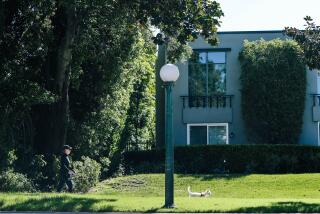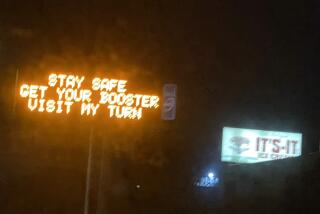9 More Cracked Signposts Removed : Transportation: A motorist was killed by a falling freeway message board last week. Caltrans tests of poles have found hairline fissures that could make them unsafe.
- Share via
RIVERSIDE — In the wake of last week’s collapse of an electronic message board that killed a freeway motorist, nine additional signs have been removed because they showed evidence of hairline fractures, Caltrans announced Monday.
The cracks may be the result of faulty welding, and most of the signs were made by the same San Fernando manufacturer, Caltrans said.
For the record:
12:00 a.m. Dec. 9, 1995 For the Record
Los Angeles Times Saturday December 9, 1995 Home Edition Metro Part B Page 3 Metro Desk 2 inches; 44 words Type of Material: Correction
Freeway sign cracks--An article in Tuesday’s Times about Caltrans’ discovery of additional cracks in poles that hold up freeway electronic message boards misstated the extent of the cracks. They were smaller than the pole crack that led to the Nov. 28 collapse of a sign that killed a motorist in Rancho Cucamonga.
Eight of the signs were along Interstates 10, 15 and 215 in Riverside and San Bernardino counties, and a ninth was on southbound Interstate 5 near Gorman, said Caltrans division maintenance chief Mike Miles.
The inspections are continuing statewide, and no other faulty signs have been found, he said.
Miles said the fractures, ranging from microscopic to several inches long, were invisible to the naked eye but were detected after structural engineers ground away the galvanized material covering the 18-inch-diameter tubular steel posts and applied a penetrating blue dye to the steel.
Last week, Caltrans removed two other signs in San Bernardino County as a precaution because they were in areas prone to high winds.
The action was prompted by the collapse of one of the five-ton message boards Nov. 28 in Rancho Cucamonga during winds of more than 60 mph. The cantilevered sign, which was hanging over the slow lane of I-15, crushed the cab of a pickup, killing 52-year-old Donald Post of Lake Arrowhead.
Caltrans officials acknowledged later that the sign, which was installed last year, showed rust where the break occurred. The victim’s family contended that the sign had an existing crack, given the rust evidence, that caused the post to be sheared off near its base in the winds.
Possible cause of the cracking of the sign poles, Miles said, was an improper grade of steel used in welding.
A proper weld, he said, would allow the poles to torque to an acceptable degree in high winds while supporting the weight of the message board. “We want a malleable pole that can be deformed and return to its natural shape without failure,” Miles said. “The more brittle it becomes, the less likely it is to return to its original shape, and then you get failure.”
If laboratory analysis shows that the proper grade of steel was used, engineers will then review the welding process, Miles said.
He said the signs were manufactured by Sierra Nevada Steel Co. in San Fernando. “What we’re looking at now is whether our [Inland Empire] district received a bad batch of poles, or if there is some other problem.”
Tom Ivey, general manager of Sierra Nevada Steel, said his firm has given Caltrans a list of the freeway message board poles it manufactured and dispatched an engineer to Sacramento to assist with the analysis of the poles.
“We’re not aware of anything in the way of welding or materials [that is faulty], and we aren’t sure that anyone has an answer as to why this thing fell,” Ivey said.
“Beyond that, we have no comment,” he said.
Miles said the newly found cracks were worse than the one on the sign that fell last week. “The question is whether we accept a certain amount of welding flaws. Whether these are acceptable or not, we have to determine. Obviously in the one that fell, it wasn’t.”
He said that because the signposts are galvanized to protect them from rust, any cracks beneath the protective coating might not be visible during routine inspections. Likewise, he said, the galvanizing material may show cracking even though the signposts themselves are not cracked.
Neither Miles nor Ivey said they knew how many of the 228 signposts statewide were manufactured by Sierra Nevada Steel. Miles said Caltrans orders the signs on a district-by-district basis through a bidding process.
More to Read
Sign up for Essential California
The most important California stories and recommendations in your inbox every morning.
You may occasionally receive promotional content from the Los Angeles Times.










